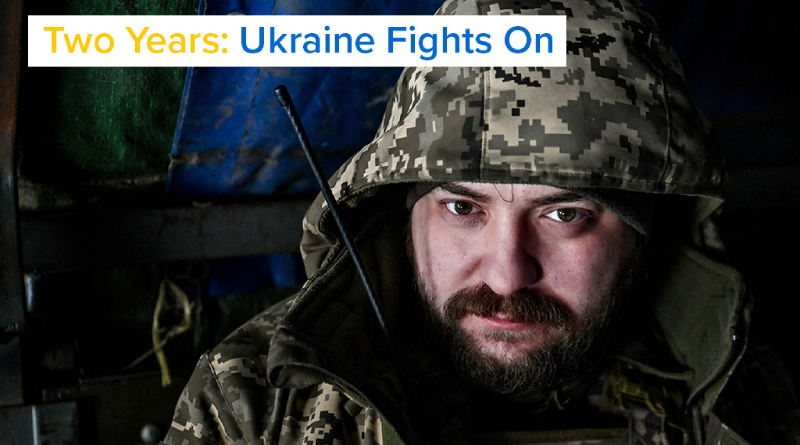Ukraine Two Years On: Sobriety, Sadness, and an Absolute Determination to Fight
Ukraine has provided vivid examples of resilience in the two years since the all-out invasion of February 24, 2022.
By Volodymyr Dubovyk, Visiting Scholar at the Fletcher Russia and Eurasia Program
Ukraine’s military, first and foremost, outperformed all expectations. But more widely, the nationwide mobilization, which included civil society, government agencies, and more, was remarkable and continues. Ukrainian society remains united against Russia’s threat to wipe it from the map.
That being said, it also seems that this resilience is now being tested in a most severe way.
It has dawned on Ukrainians that there will be no swift end to the conflict. One might argue that it is easier to fight and work at a high tempo in the short run than over a longer period of time. In a shorter conflict, the obvious asymmetry of the conflict is less decisive.
Remember that David took his chance against Goliath in a single battle for which he was better-prepared and wilier. In the longer run, this becomes more difficult, as Russia has four times the population, and therefore, a mobilization pool.
Attrition clearly benefits the Kremlin, which cares nothing for losses. This is not to mention that Russia has been successfully circumventing sanctions, and has managed to dramatically increase production of arms. It can fund the war as it continues to receive massive cash inflows from selling its resources on the international market.
The Ukrainian military has been depleted (US estimates last year suggest around 300,000 Russian dead and wounded, with Ukraine suffering about 200,000 casualties.) Some of Ukraine’s better-trained and most motivated soldiers are lost. There is currently a debate about a potential new round of mobilization, which has become somewhat divisive.
This, apparently, was one of the points of contention between President Zelenskyy and his former top military commander, General Zaluzhnyi. There is no single opinion as to what is the best way to replenish the armed forces.
But February’s withdrawal from Avdiivka underscores the dilemma: defend the town or pull back to new positions and save personnel. The new commanding general, Oleksandr Syrsky, was criticized for fighting toe-to-toe against Russian human wave attacks in Bakhmut last year; it’s clearly significant that he decided not to repeat the approach this time.
The failure of the summer/fall offensive has taken a psychological toll on the country. The successes of late 2022 had reinvigorated people. The bar was set high for 2023. The news of many fresh troops being trained abroad and equipped with some new weapons coming from Ukraine’s supporters abroad generated high expectations.
The ability of Russia to double down with its invasion, to undermine Ukraine’s offensive momentum has a discouraging effect, and delays with the supply of various arms to Ukraine have played a major role (more accurate bombs called GLSDBs have only just been delivered, F-16 combat aircraft will not arrive until the summer and longer-range ATACMS may never be sent.)
Many in Ukraine believe that if Ukraine had been given these and other arms a year earlier, this would have been a game-changer, considering that Russia at that point was struggling to find and had not yet built its massive defensive lines across Ukraine’s east and south.
Naturally, life away from the front line is severely disrupted. The reality is of frequent attacks and air raids, and there is a somber realization that anyone can be a victim. The number of people displaced — within Ukraine and beyond its borders — remains enormous.
The figures are horrendous. From a population of 43 million, some 6.3 million people have left the country, 3.7 million are internally displaced and 14.6 million need humanitarian aid.
It was easier for some of them, especially internally displaced persons, to get by for a short period but it has now been two years. Millions of jobs were lost, and inflation remains high.
None of this means that Ukrainians are willing to surrender, but the mood has become more sober even than in the days of the initial shock of the massive invasion. At the same time, there never really was a choice for Ukrainians — they could not stop fighting. This fight is existential.
Ukrainians, for a good reason, do not believe that Putin is ready to negotiate and that he is sincerely willing to stop the aggression. There will be no trust in his word or a signature under some sort of a ceasefire agreement. There is an understanding that his determination to destroy Ukraine’s sovereignty has not changed. There is a fear that Russia might trick Ukraine with some lure of fair negotiations while simply accumulating forces for a new round of aggression.
This grim and realistic assessment should in no way serve as an excuse to diminish the readiness of the pro-Ukraine international coalition to stick to their current unconditional support.
The EU found a way to approve its new €50bn ($54bn) aid package on February 1.
There is a hope that the US House of Representatives will ultimately do the right thing too, after trying everything else.
With a smaller fighting force, Ukraine depends on the supply of contemporary weapons systems more than ever. The war is far from being lost, by any assessment.
Remember that the Russian military is exhausted too, its best units have been shredded, and the pressure must be maintained.
Ukraine has demonstrated its ability to do wonders with whatever support it is given, including its spectacular successes in its Black Sea campaign.
The Russian threat remains, both for Ukraine and for others in the focus of its acquisitive gimlet eye. There should be an increased sense of urgency to confront it and to reject any suggestion of an accommodation with the aggressor.
(This post is republished from CEPA.)

